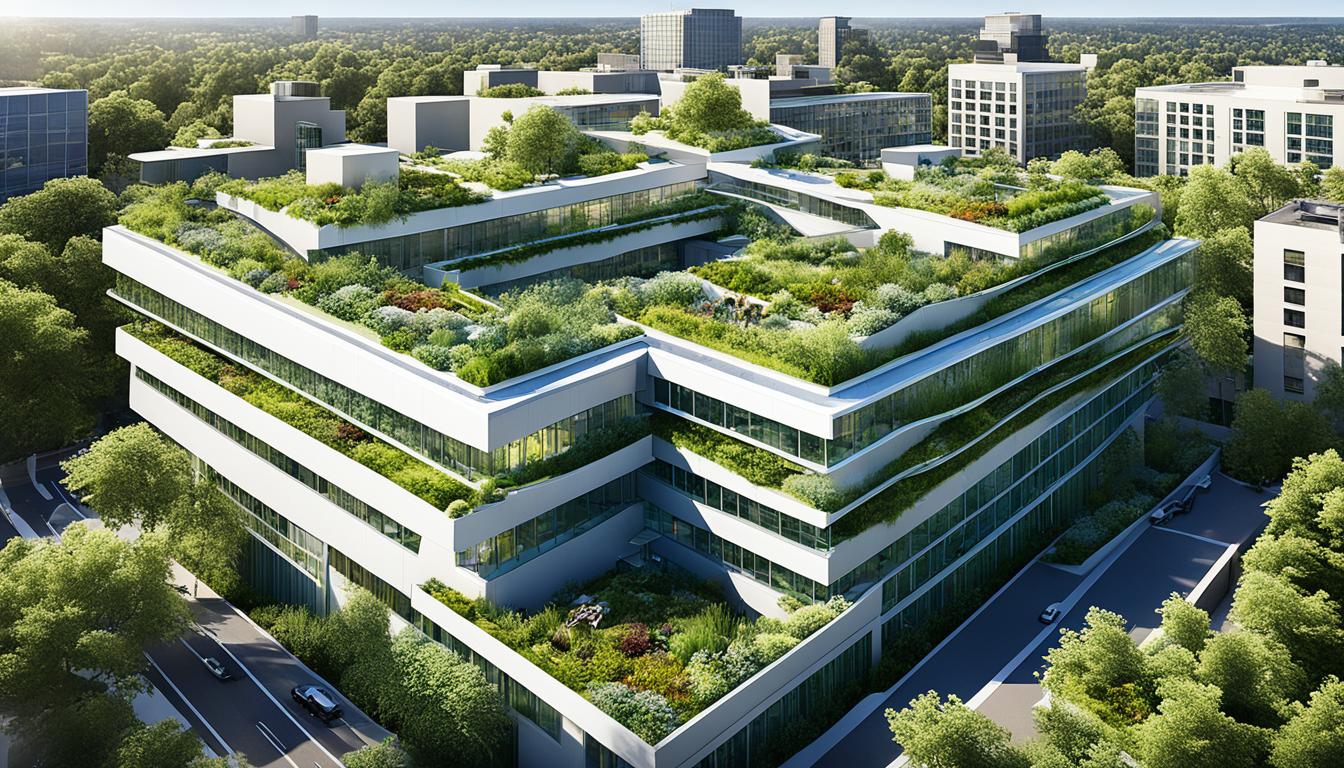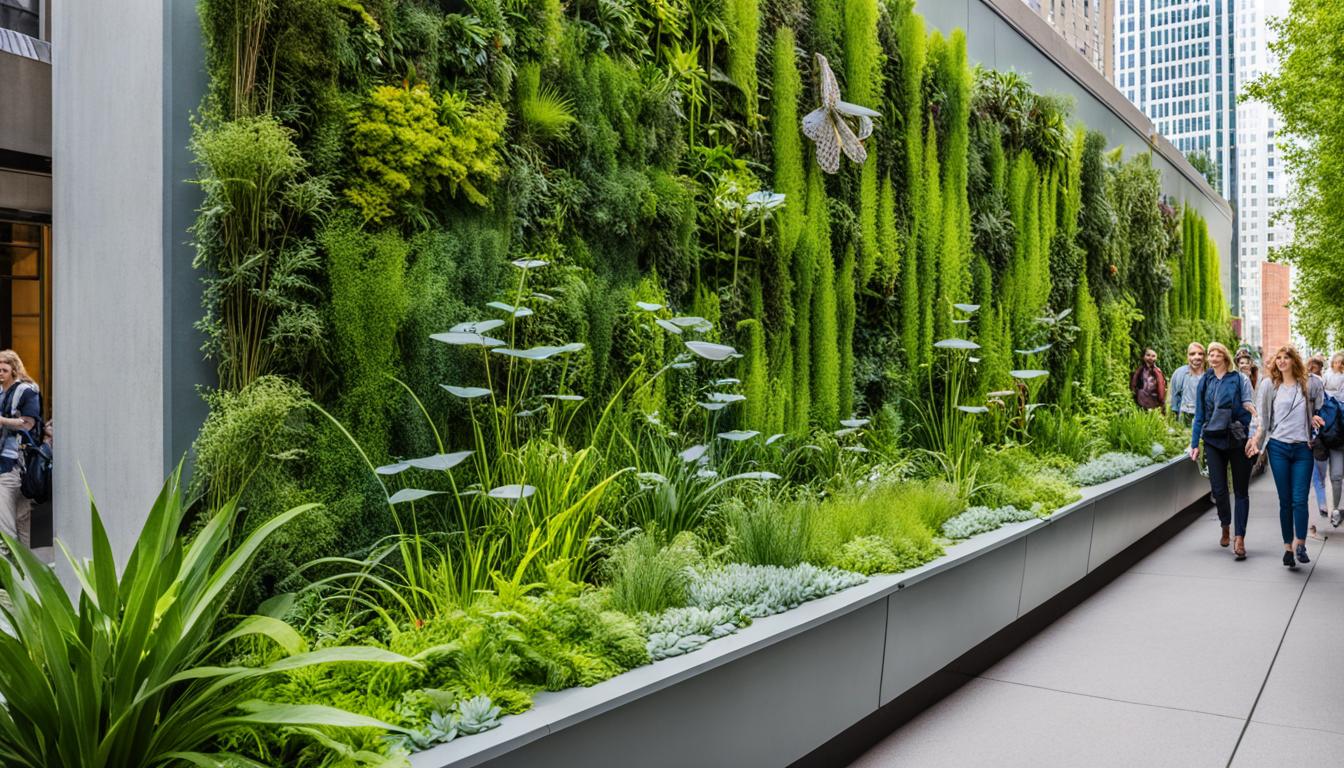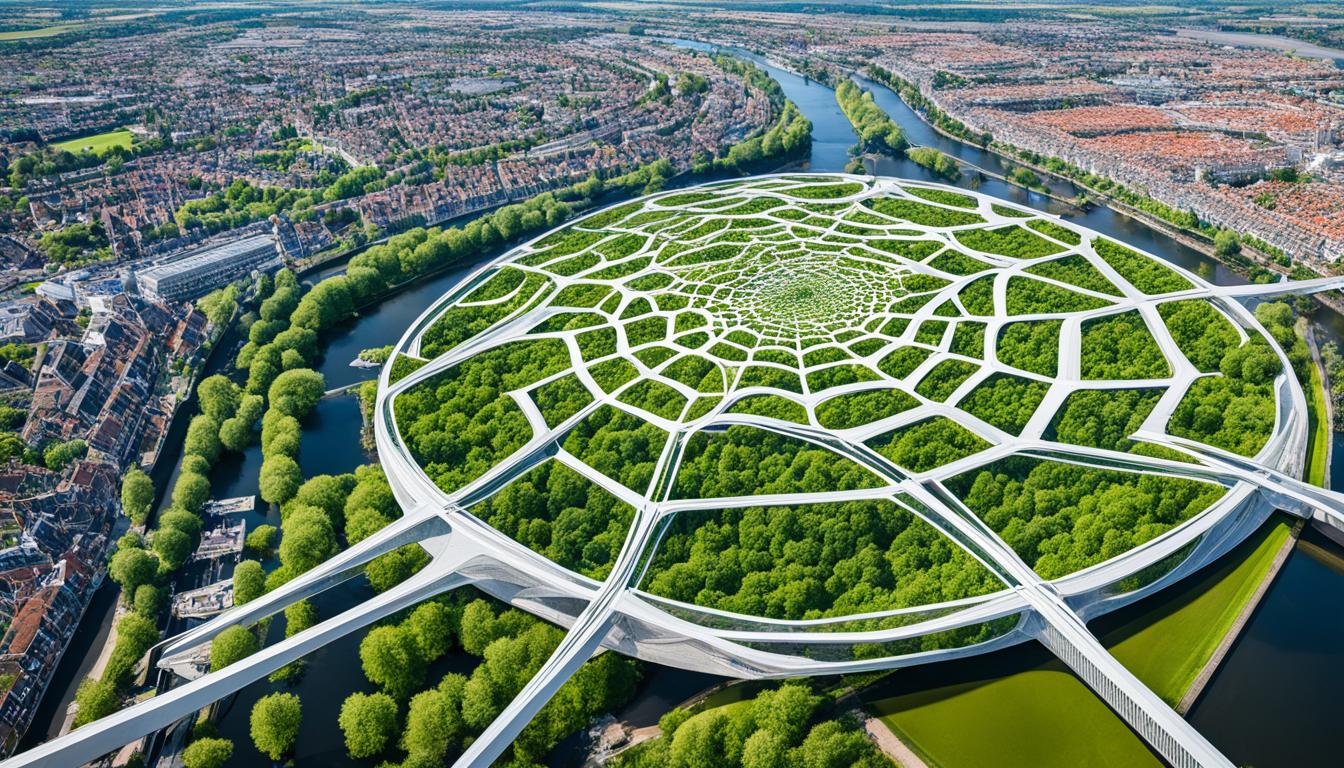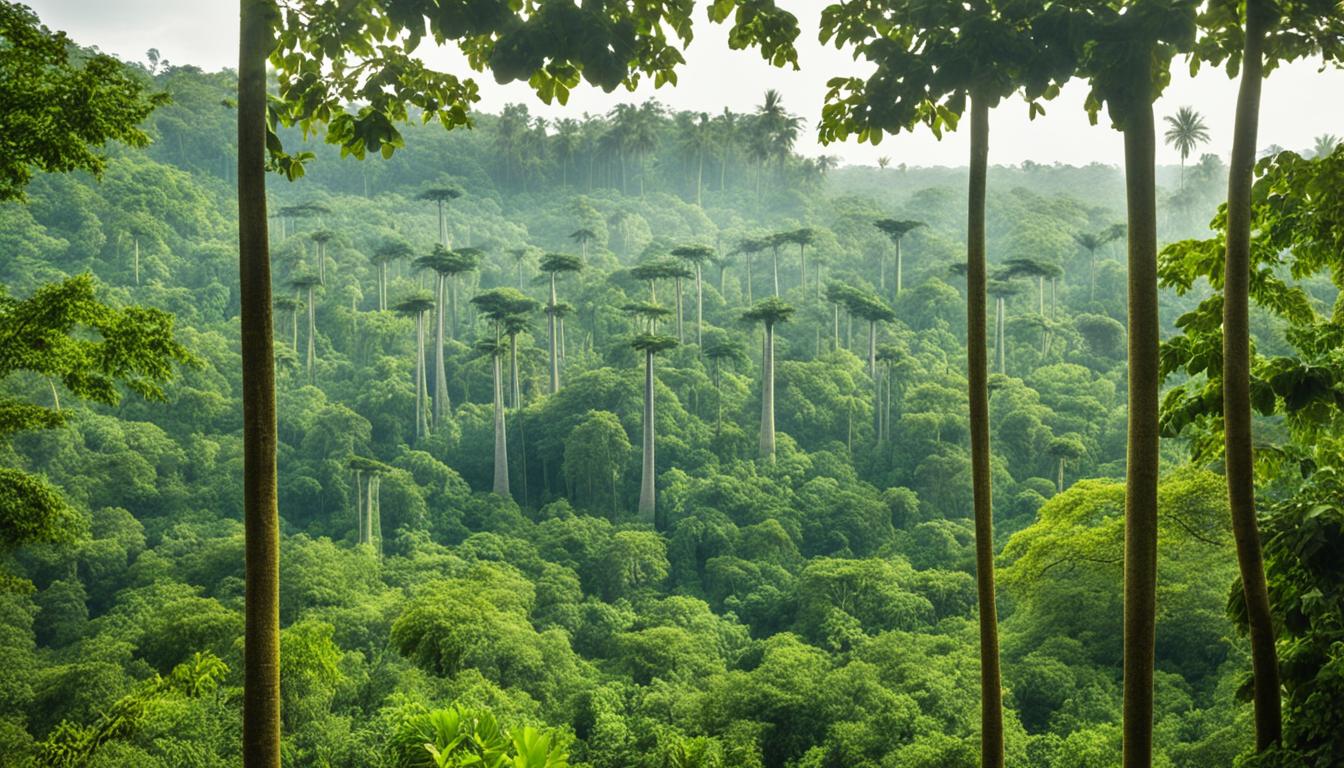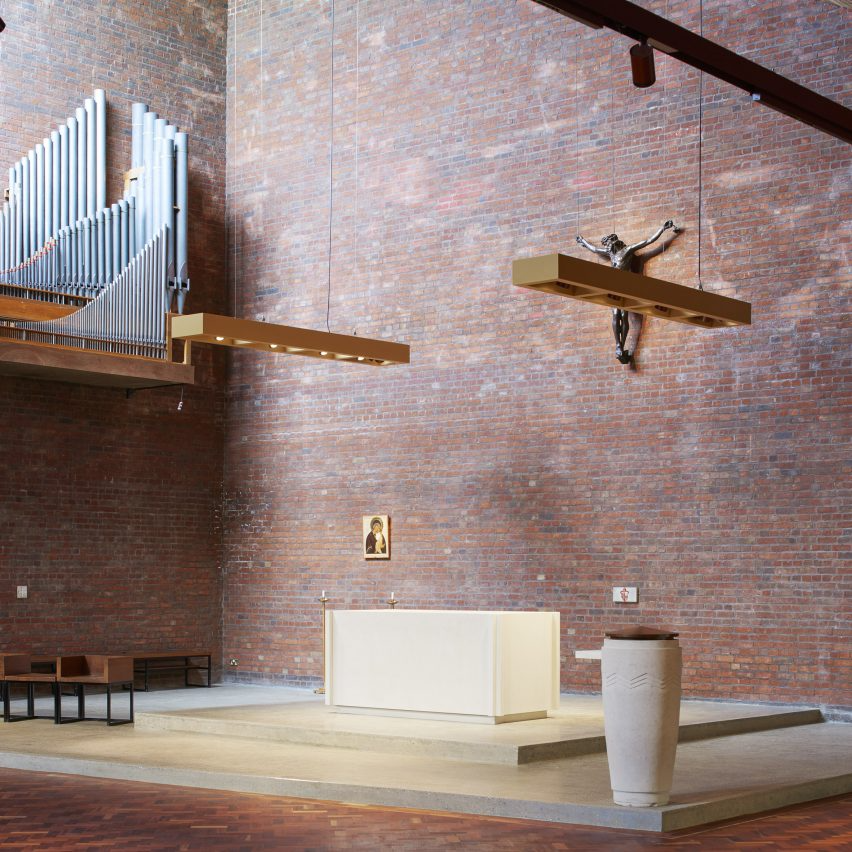Sustainable Architecture: Creating Wildlife Corridors in Urban Landscapes
Fifty-five percent of the world’s population already lives in towns and cities. This number is expected to jump to over 68% by 2050. This growth is a big problem for wildlife in and around cities.
They have to deal with less space to live, getting hit by cars, and more. Plus, they fight with new animals that people bring in. It’s important to protect these urban animals for many reasons. One is that it makes city life nicer for people. Seeing animals in the city can make us feel happy and calm. Sadly, not everyone gets to enjoy nature in the city. People who don’t have much money or come from different backgrounds might miss out on this.
But, we can do something about this problem. Making paths for animals in the city can help. This way, animals and people can live together better. Everyone wins when we think about wildlife in cities.
Key Takeaways
- Over 55% of the world’s population already lives in urban areas, a figure expected to rise to 68% by 2050.
- Rapid urbanisation poses a significant threat to wildlife through habitat fragmentation, vehicle-wildlife collisions, and competition with introduced species.
- Safeguarding urban wildlife populations benefits both conservation efforts and the wellbeing of city inhabitants.
- Positive human-wildlife interactions have immense psychological benefits, yet urbanisation diminishes these opportunities.
- Developing effective strategies for urban wildlife conservation, such as creating successful wildlife corridors, can strengthen the bond between biodiversity and city dwellers.
The Importance of Urban Wildlife Corridors
City life puts pressure on the natural world, leading to a big issue called habitat fragmentation. To help, wildlife corridors link up separate animal groups, giving them more space to live. They help animals move more freely, mix their genes, and reduce dangers like getting hit by cars.
Mitigating Habitat Fragmentation
With cities growing fast, it’s key to keep nature connected. Wildlife corridors help by offering a safe way for animals to travel through our cities. This movement lessens the bad impact that urban areas can have on wildlife.
Promoting Urban Biodiversity
Good wildlife corridors in cities can do wonders for local life. They give a path for many creatures to find food, protection, and a way to get around. By making a web of habitats, we can look after the many species that call our cities home.
Enhancing Ecological Connectivity
With climates changing, wildlife corridors are more important than ever. They help animals move, letting them find new homes and food as needed. This makes sure our city environments can keep supporting life even as things change.

Challenges of Urban Wildlife Conservation
Conserving wildlife in cities is tough. It involves dealing with needs of both humans and animals. To do this well, we need to work together, think beyond usual boundaries, and break old habits.
Balancing Human and Wildlife Needs
Managing space between people and animals is hard in cities. Urban areas focus a lot on human activities. This often leaves no space for wildlife’s homes.
We need to find ways for everyone to live together. This means finding room for animals in our city plans.
Stakeholder Collaboration
Many different people and groups need to work together for wildlife. In cities, this is even more complicated. The many players, from residents to builders, planners to protectors, all play a role.
Getting everyone on the same page is vital. It’s key to making good conservation happen in our cities.
Disciplinary Silos
Separate disciplines can get in the way. Each group has its own roles and methods. But, to help wildlife in cities, they must all come together.
This teamwork can build better plans. Plans that consider every piece of the complex urban puzzle.
Urban Sprawl and Jurisdictional Boundaries
Cities spreading out make saving wildlife harder. The borders between areas add another hurdle. Working across these lines for conservation is no easy task.
But, it’s important to join forces across the city to help animals. Strategies need to work for the whole urban region, not just parts of it.
A smart, united effort can make our cities better homes for both us and wildlife. This way, cities can support a rich variety of animals.

Creating Wildlife Corridors in Urban Landscapes
Setting up urban wildlife corridors helps preserve nature pathways through cities. These areas link up natural spaces for animal travel. They can improve conservation in urban areas. By using a mix of strategies like creating green spaces and encouraging restoration at home, we can join efforts. This connects different places for animals to move across and involves many people. Still, complete guides on how to do this well are rare.
| Approach | Benefits | Challenges |
|---|---|---|
| Green Infrastructure | Promotes urban biodiversity and enhances habitat connectivity | Requires coordination across multiple stakeholders and land parcels |
| Backyard Habitat Restoration | Empowers residents to contribute to wildlife corridors in their own spaces | Limited space and maintenance needs in urban settings |
| Land Acquisitions and Conservation Partnerships | Secures key parcels to establish continuous habitat corridors | Navigating complex land ownership and jurisdictional boundaries |
A smart mix of creating green areas, engaging communities, and planning the land can lead to better urban nature. This approach makes cities more welcoming for wildlife and helps animals move around. It is a way to improve the habitat in cities for many species.
Assessing and Prioritising Conservation Areas
Before making habitats and corridors, we must look at the site. This includes doing site surveys, collecting data with GIS mapping, and other steps. This helps us understand the site’s conditions and potential.
Site Surveys and Inventories
Site surveys find out about the area’s plants, soil, water, land, and animals. This knowledge is key to making suitable habitats and paths for nature.
GIS Mapping and Spatial Analysis
GIS mapping gives us a detailed look at the site. It helps us find important spots. With this technology, we can better plan urban animal paths.
Ecological Models and Indicators
We use ecological models to check the quality of habitats. They look at how well animals can move around, their needs, and what might block them. These models guide us in using scientific approaches for planning.

Green Infrastructure Solutions
Urban landscapes can greatly benefit from green architecture. By using sustainable design and eco-friendly practices, we can boost wildlife habitats. This approach helps maintain and grow biodiversity in urban areas.
Native Planting and Habitat Restoration
Native plants are vital for city wildlife. They provide food and shelter for birds, bees, and small animals. This supports the health of the ecosystem, improves the air, and tackles urban heat.
City gardens made of native plants can be like highways for wildlife. They connect green areas, helping animals move around. These gardens make cities look better and bring people closer to nature.
Green Roofs and Vertical Gardens
City buildings can do more for nature with green roofs and vertical gardens. These high-up spaces are perfect for pollinators and birds. They make a network of habitats that are good for many urban wildlife species.
Permeable Surfaces and Stormwater Management
Using permeable surfaces and managing stormwater is key to green design. These methods lessen flooding and protect local water systems. They also create environments that are adaptable and welcoming to various species.

Backyard Habitat Restoration
Every urban resident can help create wildlife corridors. Even small spaces like gardens, balconies, or rooftops can be part of the network. Planting native species is crucial as they support local wildlife. Many cities offer resources and advice for these efforts.
Engaging Communities
Setting up wildlife corridors in cities is challenging. There are limits on space, rules from urban planning, and the need for constant upkeep. Yet, there are solutions like using vertical gardens and working with the community. By getting everyone involved, we can take better care of our shared environment and encourage more people to join in.
Native Plant Distribution
Cities are helping people restore their backyards through projects that distribute native plants. These efforts involve local volunteers and use detailed plans to spread the word. By sharing information on native plants and how to grow them, cities are helping residents make a real difference in their own spaces.
Educational Outreach
Programmes that teach about native plants are vital for community engagement. They explain why urban biodiversity is crucial and how native plants help. They also give practical advice for making gardens wildlife-friendly, inspiring residents to care for their local plants and animals. Such initiatives deepen everyone’s understanding of how they can support nature in the city.

Land Acquisition and Conservation Partnerships
We started a project to give out native plants to people wanting to improve their backyards. Local volunteers helped a lot. We also created a big database. This helped us teach people about the beauty of native plants and the importance of working together.
Our aim was to get more people involved in looking after the natural spaces around them. This work led to building better relationships and working together to protect nature in our towns and cities.
Prioritising Parcels for Conservation
We carefully check each area to decide which ones are most important to save. We use special maps and tools to understand the land and its natural value. This way, we choose the right areas that are good for wildlife and the planet.
This detailed work helps ensure our choices are the best for everyone, including the environment. It makes our work more likely to help both wildlife and the places where we live.
Working with Landowners and Developers
It’s key to talk to people who own land or want to build on it when making wildlife corridors. By working together with these owners and developers, we find ways that are good for everyone. This helps the local community and nature live well side by side.
Together, we’re finding new solutions to use land in a way that protects nature. This means we can keep parts of land wild, even when we build new things.
Establishing Conservation Easements
Using conservation easements is a smart way to save areas for wildlife in cities. These are special agreements with landowners. They promise to keep parts of their land safe for the future. With these deals, we’re sure those places will stay good for plants and animals, even as cities grow.

Monitoring and Evaluation
We set up camera traps to watch over the wildlife in a specific area. Along with the camera traps, we gathered information from people living nearby. This mix of camera trapping and citizen science gave us a deep look into the lives of animals.
Camera Trapping and Citizen Science
Camera traps helped us see what animals did when humans weren’t around. This let us understand how they interact with our cities. We also got locals involved with citizen science to add their findings. This helped paint a clearer picture of the urban wildlife.
Biodiversity Indicators
We used biodiversity indicators to check the health of the wildlife and plants around us. By focusing on specific species and the quality of their homes, we could tell if our plans were working. This info guided us to improve our efforts for the future.
Adaptive Management
Urban areas are always changing. So, we kept an open mind and adjusted our conservation plans when needed. This way, our work stayed effective despite new problems or discoveries. Adapting has made our wildlife spaces stronger over time.

Conclusion
The growth of wildlife corridors in cities has a big effect on biodiversity. These green paths help many species to live and move. They also make city people feel part of nature, encouraging care for wild animals and plants. This unites city life with the work of nature conservation.
Creating wildlife corridors with gardens full of native plants is key for keeping nature diverse in cities. All city folks, along with planners, have a big role in merging city and country life. They help build a space where humans and wildlife can thrive together.
By using smart green infrastructure solutions, like planting native species and building natural habitats, we fight against the breaking up of homes for wild animals and plants. This strategy makes nature more connected in cities that care. It doesn’t just look after city nature but also improves life for everyone in the city.
FAQ
What are the key benefits of creating wildlife corridors in urban landscapes?
Wildlife corridors in cities help bridge gaps between habitats. This promotes biodiversity and connects ecosystems. They allow animals to travel safely, increasing genetic diversity and population strength.
What are the main challenges in establishing wildlife corridors in cities?
The main challenge is finding a balance between people’s needs and nature’s. It involves working with many parties, breaking down boundaries, and dealing with city expansion’s effects on nature.
How can site assessments and spatial analysis help in designing effective urban wildlife corridors?
Surveying sites and mapping with GIS are essential. They give us information on landscapes, plant life, and obstacles. This data helps in designing the best paths for animals.
What role can green infrastructure solutions play in supporting urban wildlife corridors?
Innovative green solutions like green roofs can connect areas for wildlife. They provide food, shelter, and safer travel routes. These methods benefit wildlife and improve the environment.
How can local communities contribute to the development of urban wildlife corridors?
People can help by restoring their gardens and giving out local plants. Educating the public about the importance of these corridors engages them in the process.
What strategies are used to prioritise conservation areas and secure land for urban wildlife corridors?
One way is to map empty spaces and work with land owners. By creating conservation zones, we protect important natural areas and corridors for animals.
How do monitoring and evaluation help ensure the long-term success of urban wildlife corridors?
Techniques like camera trapping and getting the public involved are crucial. They help us check how corridors are working and make the needed improvements for wildlife.



